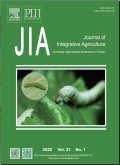首页|期刊导航|农业科学学报(英文)|Comparison of CWSI and Ts-Ta-VIs in moisture monitoring of dryland crops(sorghum and maize)based on UAV remote sensing
农业科学学报(英文)2024,Vol.23Issue(7):2458-2475,18.DOI:10.1016/j.jia.2024.03.042
Comparison of CWSI and Ts-Ta-VIs in moisture monitoring of dryland crops(sorghum and maize)based on UAV remote sensing
Comparison of CWSI and Ts-Ta-VIs in moisture monitoring of dryland crops(sorghum and maize)based on UAV remote sensing
摘要
关键词
maize/sorghum/Ts-Ta-VIs/CWSI/UAV/machine learning/crop moisture monitoringKey words
maize/sorghum/Ts-Ta-VIs/CWSI/UAV/machine learning/crop moisture monitoring引用本文复制引用
Hui Chen,Hongxing Chen,Song Zhang,Shengxi Chen,Fulang Cen,Quanzhi Zhao,Xiaoyun Huang,Tengbing He,Zhenran Gao..Comparison of CWSI and Ts-Ta-VIs in moisture monitoring of dryland crops(sorghum and maize)based on UAV remote sensing[J].农业科学学报(英文),2024,23(7):2458-2475,18.基金项目
This work was supported by the National Key Research and Development Program of China(2022YFD1901500/2022YFD1901505),the Key Laboratory of Molecular Breeding for Grain and Oil Crops in Guizhou Province,China(Qiankehezhongyindi(2023)008),and the Key Laboratory of Functional Agriculture of Guizhou Provincial Higher Education Institutions,China(Qianjiaoji(2023)007).We thank Dr.Robert McKenzie from Liwen Bianji(Edanz)(www.liwenbianji.cn)for editing a draft of this manuscript. (2022YFD1901500/2022YFD1901505)

